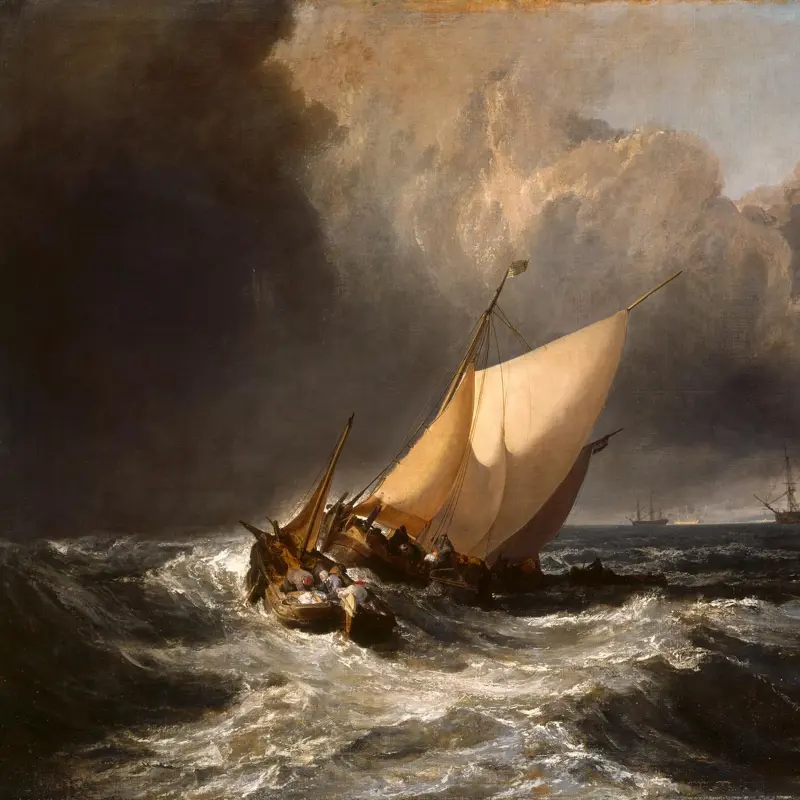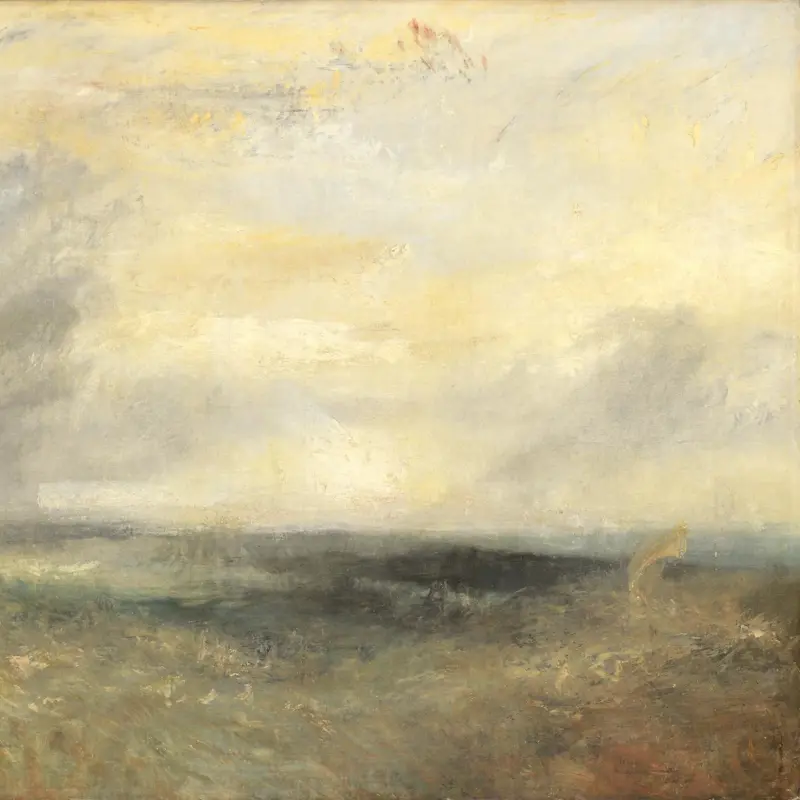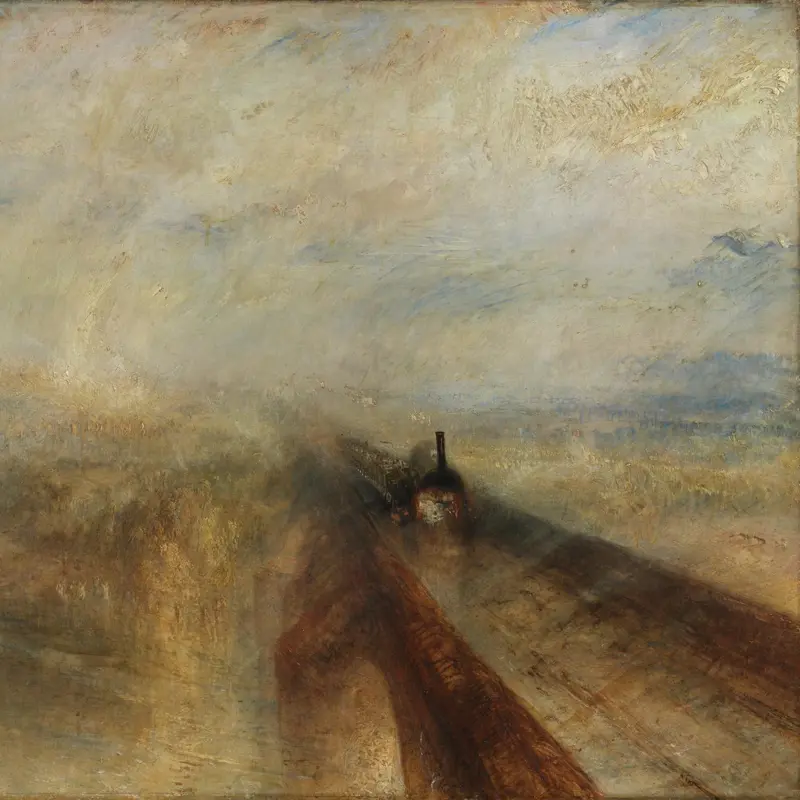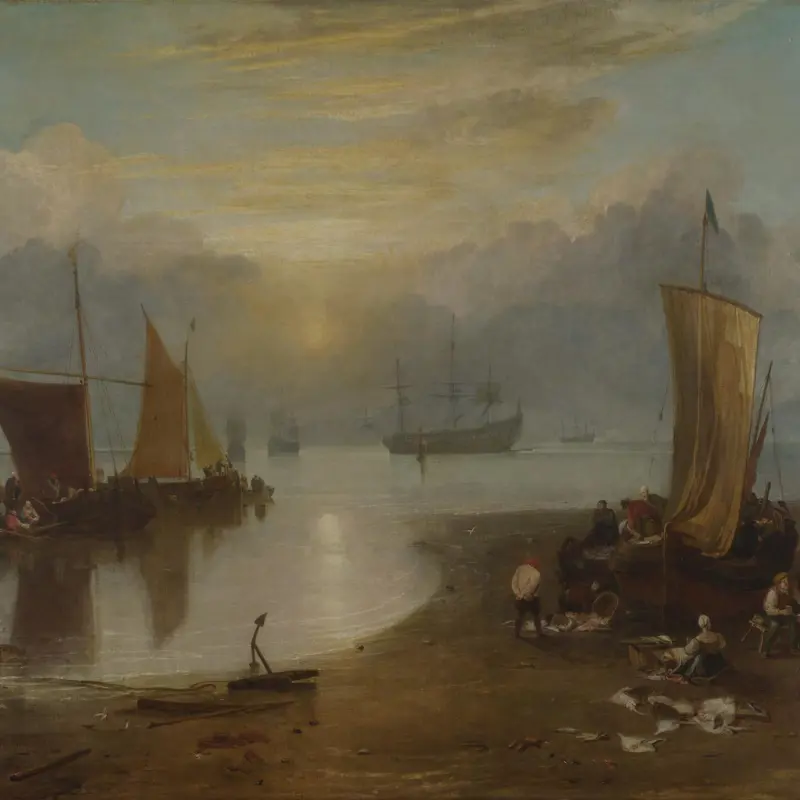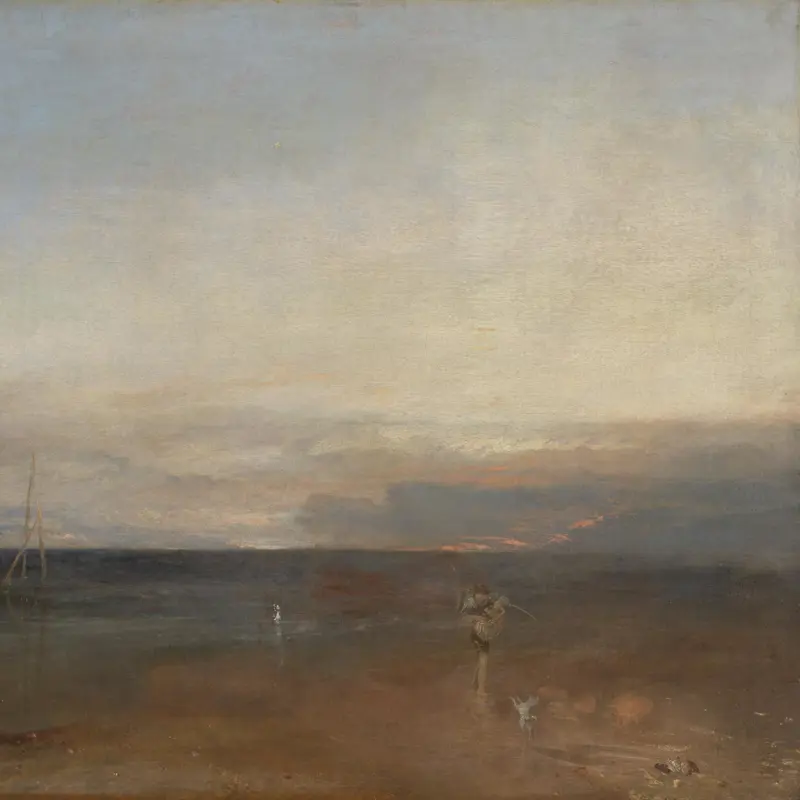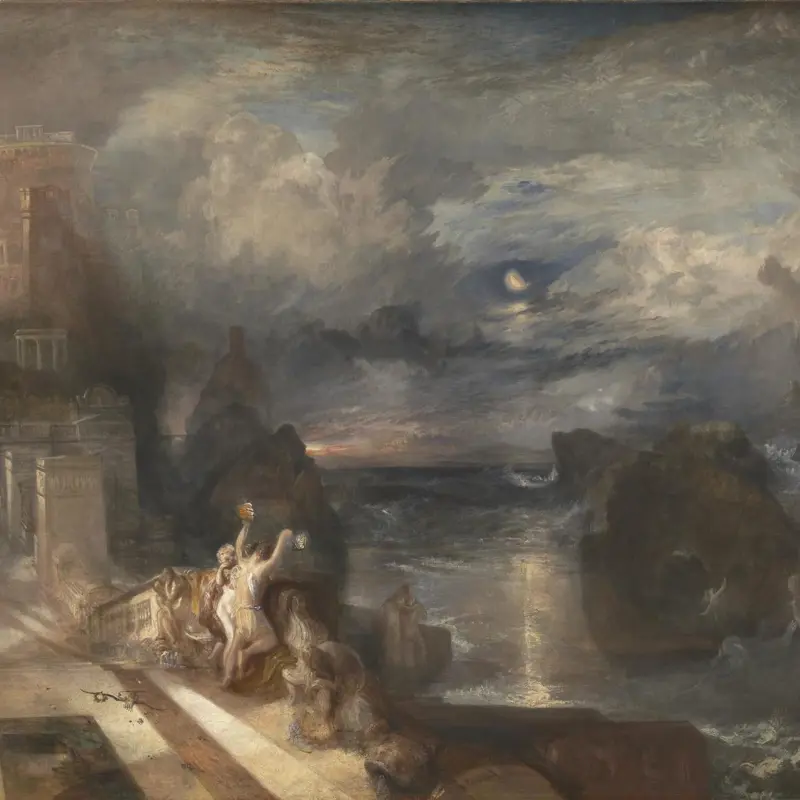Joseph Mallord William Turner, 'Ulysses deriding Polyphemus - Homer's Odyssey', 1829
About the work
Overview
The subject of this painting is taken from Book IX of Homer’s Odyssey. It shows Ulysses sailing from the island where Polyphemus, a one-eyed giant, had held him and his men captive. Wearing a helmet and a scarlet cloak, Ulysses raises his arms in victory as he stands on the deck of his ship, below a red banner, looking back at the island. He lifts the flaming torch with which he blinded Polyphemus, whose huge shadowy body lies sprawled across the clifftop that towers above. Luminous sea nymphs and flying fish gather at the ship’s prow as a blazing sun rises through the morning mists.
The painting signals the increasing role of colour and light in Turner’s historical landscapes. It also marks the increasingly expressive direction his painting was to follow and anticipates the visionary qualities of his late work. Writing in 1856, the English art critic John Ruskin declared it to be ‘the central picture of Turner’s career'.
Key facts
Details
- Full title
- Ulysses deriding Polyphemus - Homer's Odyssey
- Artist dates
- 1775 - 1851
- Date made
- 1829
- Medium and support
- oil on canvas
- Dimensions
- 132.5 × 203 cm
- Acquisition credit
- Turner Bequest, 1856
- Inventory number
- NG508
- Location
- Room 40
- Collection
- Main Collection
- Previous owners
- Frame
- 19th-century English Frame (original frame)
Provenance
Additional information
Text extracted from the ‘Provenance’ section of the catalogue entry in Judy Egerton, ‘National Gallery Catalogues: The British Paintings’, London 2000; for further information, see the full catalogue entry.
Exhibition history
-
2015Danger and Beauty. William Turner and the Tradition of the SublimeRijksmuseum Twenthe5 September 2015 - 3 January 2016
-
2016JMW Turner: Adventures in ColourTurner Contemporary8 October 2016 - 8 January 2017
-
2018Thomas Cole: Eden to EmpireThe Metropolitan Museum of Art30 January 2018 - 13 May 2018The National Gallery (London)11 June 2018 - 7 October 2018
-
2020Masterpieces from the National Gallery, LondonThe National Museum of Western Art18 June 2020 - 18 October 2020The National Museum of Art3 November 2020 - 31 January 2021
-
2021Botticelli to Van Gogh: Masterpieces from the National Gallery, LondonNational Gallery of Australia5 March 2021 - 14 June 2021
Bibliography
-
1857J. Ruskin, Notes on the Turner Gallery at Marlborough House, 1856, London 1857
-
1857R.N. Wornum, Descriptive and Historical Catalogue of the Pictures in the National Gallery, with Biographical Notices of the Painters: British School, London 1857
-
1870E. Eastlake, Contributions to the Literature of the Fine Arts, 2nd edn, London 1870
-
1903J. Ruskin, Modern Painters, eds E.T. Cook and A. Wedderburn, The Works of John Ruskin, 39 vols, London 1903
-
1908W.G. Rawlinson, The Engraved Works of J.M.W. Turner, 2 vols, London 1908
-
1910A.J. Finberg, Turner's Sketches and Drawings, London 1910
-
1930W.T. Whitley, Art in England 1821-1837, Cambridge 1930
-
1946Davies, Martin, National Gallery Catalogues: British School, London 1946
-
1946M. Davies, Paintings and Drawings on the Backs of National Gallery Pictures, London 1946
-
1956A. Pigler, Barockthemen: Eine auswahl von Verzeichnissen zur Ikongraphie des 17. und 18. Jahrhunderts, Budapest 1956
-
1958D. Farr, William Etty, London 1958
-
1959Davies, Martin, National Gallery Catalogues: British School, 2nd edn (revised), London 1959
-
1968J. Gage, 'Turner's Academic Friendships: C.L. Eastlake', The Burlington Magazine, CX/789, 1968, pp. 676-85
-
1969J. Gage, Colour in Turner: Poetry and Truth, London 1969
-
1969D. Hirsch, The World of Turner, New York 1969
-
1977K.D. Nicholson, J.M.W. Turner's Images of Antiquity, Phd Thesis, University of Pennslyvania 1977
-
1981W. Gaunt, Turner, Oxford 1981
-
1981W. Chubb, 'Minerva Medica and the Tall Trees', Turner Studies, I/2, 1981, pp. 26-35
-
1981J. Gage, 'Turner and the Greek Spirit', Turner Studies, I/2, 1981, pp. 14-23
-
1982M. Butlin and E. Joll, L'opera completa di Turner 1793-1829, Milan 1982
-
1984M. Butlin and E. Joll, The Paintings of J.M.W. Turner, R.A., New Haven 1984
-
1990D. Birch, Ruskin on Turner, London 1990
-
1990S. Ginzburg, Turner, New York 1990
-
1990E. Shanes, Turner's Human Landscape, London 1990
-
1990E. Shanes, Turner: The Masterworks, London 1990
-
1994A. Thomas, An Illustrated Dictionary of Narrative Painting, London 1994
-
1995G. Finley, 'J.M.W. Turner and the Legacy of Greece', Gazette des beaux-arts, CXXVI/1522, 1995, pp. 187-94
-
1995R. White and J. Pilc, 'Analyses of Paint Media', National Gallery Technical Bulletin, XVI, 1995, pp. 85-95
-
1997A. Bailey, Standing in the Sun: A Life of J.M.W. Turner, London 1997
-
1997J. Hamilton, Turner: A Life, London 1997
-
1997M.D. Rincón de Arellano, 'Turner visto por sus contemporáneos', Goya, 256, 1997, pp. 235-40
-
1997D.B. Brown et al., Joseph Mallord William Turner (exh. cat. Bank Austria Kunstforum, 5 March - 1 June 1997), Vienna 1997
-
1998J. Egerton, The British School, London 1998
-
2000Egerton, Judy, National Gallery Catalogues: The British Paintings, revised edn, London 2000
-
2001
C. Baker and T. Henry, The National Gallery: Complete Illustrated Catalogue, London 2001
About this record
If you know more about this work or have spotted an error, please contact us. Please note that exhibition histories are listed from 2009 onwards. Bibliographies may not be complete; more comprehensive information is available in the National Gallery Library.



